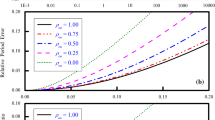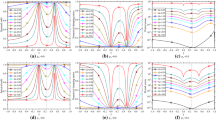Abstract
In order to acquire efficient algorithms for complicated problems in structural dynamics, an improved integration algorithm with controllable numerical dissipation is developed based on a two-step explicit acceleration integration method. The improved method is a step-by-step integration scheme which is conditionally stable and robust in strongly nonlinear systems. The consistency, accuracy and the stability are analyzed for the improved method. Linear and nonlinear examples are employed to confirm the properties of the improved method. The results manifest that the improved method can be of second-order accuracy. It can be marginally stable in dynamic systems. The improved method possesses the property of energy conservation in conservative systems. Moreover, it is controllable for the numerical dissipation or algorithm damping which can be zero. The high-frequency oscillation can be effectively inhibited in a stiff problem. The spurious oscillation caused by the spatial discretization can be almost completely suppressed by the controllable numerical dissipation in a rod or a cantilever beam. It is applicable in transient and wave propagation problems.




















Similar content being viewed by others
References
Wen, W., Jian, K., Luo, S.: An explicit time integration method for structural dynamics using septuple B-spline functions. Int. J. Numer. Methods Eng. 97(9), 629–657 (2014)
Mosqueda, G., Ahmadizadeh, M.: Iterative implicit integration procedure for hybrid simulation of large nonlinear structures. Earthq. Eng. Struct. Dyn. 40(9), 945–960 (2011)
Shang, X.J., Su, J.Y., Wang, H.F.: Dynamic Analysis Method and Engineering Examples of ANSYS/LS-DYNA, 2nd edn. China Waterpower Press, Beijing (2008)
Hoff, C., Taylor, R.L.: Higher derivative explicit one step methods for non-linear dynamic problems, part I: design and theory. Int. J. Numer. Methods Eng. 29(2), 275–290 (1990)
Gro, M., Betsch, P., Steinmann, P.: Conservation properties of a time FE method. Part IV: higher order energy and momentum conserving schemes. Int. J. Numer. Methods Eng. 63(13), 1849–1897 (2005)
Idesman, A.V., Schmidt, M., Sierakowski, R.L.: A new explicit predictor-multicorrector high-order accurate method for linear elastodynamics. J. Sound Vib. 310(1–2), 217–229 (2008)
Har, J., Tamma, K.K.: Advances in Computational Dynamics of Particles, Materials and Structures. Wiley, New York (2012)
Zhou, X., Tamma, K.K.: Design, analysis and synthesis of generalized single step solve and optimal algorithms for structural dynamics. Int. J. Numer. Methods Eng. 59, 597–668 (2004)
Li, C.Q., Lou, M.L., Jiang, L.Z.: Transformation of implicit method to explicit method for solving structural dynamic equation. J. Vib. Shock 31(13), 91–94 (2012)
Chang, S.Y.: Dissipative, noniterative integration algorithms with unconditional stability for mildly nonlinear structural dynamic problems. Nonlinear Dyn. 79, 1625–1649 (2015)
Chang, S.Y.: A new family of explicit method for linear structural dynamics. Comput. Struct. 88(11–12), 755–772 (2010)
Chen, C., Ricles, J.M.: Development of direct integration algorithms for structural dynamics using discrete control theory. J. Eng. Mech. 134, 676–683 (2008)
Gui, Y., Wang, J.T., Jin, F., et al.: Development of a family of explicit algorithms for structural dynamics with unconditional stability. Nonlinear Dyn. 77, 1157–1170 (2014)
Du, X., Yang, D., Zhou, J., et al.: New explicit algorithms with controllable numerical dissipation for structural dynamics. Int. J. Struct. Stab. Eng. 18(3), 1–25 (2018)
Kuo, S.R., Yao, J.D., Yang, Y.B.: A robust time-integration algorithm for solving nonlinear dynamic problems with large rotations and displacements. Int. J. Struct. Stab. Eng. 12(6), 1–24 (2012)
Yang, C., Li, Q., Xiao, S.: Non-iterative explicit integration algorithms based on acceleration time history for nonlinear dynamical systems. Arch. Appl. Mech. 90(2), 397–413 (2020)
Hilbert, H.M.: Collocation, dissipation and ‘overshoot’ for time integration schemes in structural dynamics. Earthq. Eng. Struct. Dyn. 6(1), 116–124 (1978)
Erlicher, S., Bonaventura, L., Bursi, O.S.: The analysis of the generalized-\(\alpha \) method for non-linear dynamic problems. Comput. Mech. 28, 83–104 (2002)
Bonelli, A., Bursi, O.S., Mancuso, M.: Explicit predictor-multicorrector time discontinuous Galerkin methods for non-linear dynamics. J. Sound Vib. 256(4), 695–724 (2002)
Nikolic, A.: Free vibration analysis of a non-uniform axially functionally graded cantilever beam with a tip body. Arch. Appl. Mech. 87, 1227–1241 (2017)
Acknowledgements
The authors would like to acknowledge the support provided by the National Key Research and Development Program of China (2016YFB1200403, 2016YFB1200505) and the National Natural Science Foundation of China (11790281).
Author information
Authors and Affiliations
Corresponding author
Ethics declarations
Conflict of interest
On behalf of all authors, the corresponding author states that there is no conflict of interest.
Additional information
Publisher's Note
Springer Nature remains neutral with regard to jurisdictional claims in published maps and institutional affiliations.
Rights and permissions
About this article
Cite this article
Yang, C., Wang, X., Li, Q. et al. An improved explicit integration algorithm with controllable numerical dissipation for structural dynamics. Arch Appl Mech 90, 2413–2431 (2020). https://doi.org/10.1007/s00419-020-01729-9
Received:
Accepted:
Published:
Issue Date:
DOI: https://doi.org/10.1007/s00419-020-01729-9




